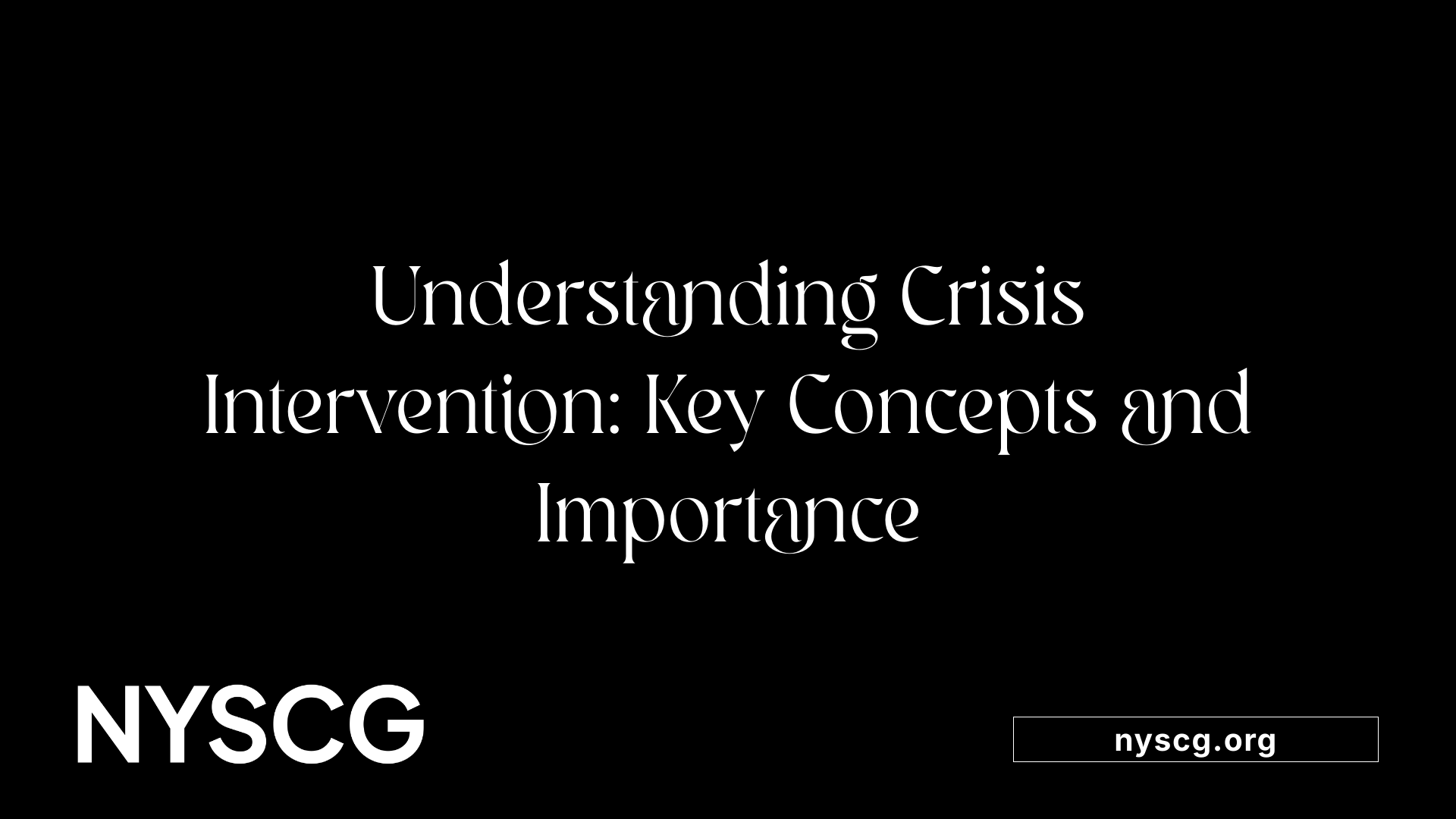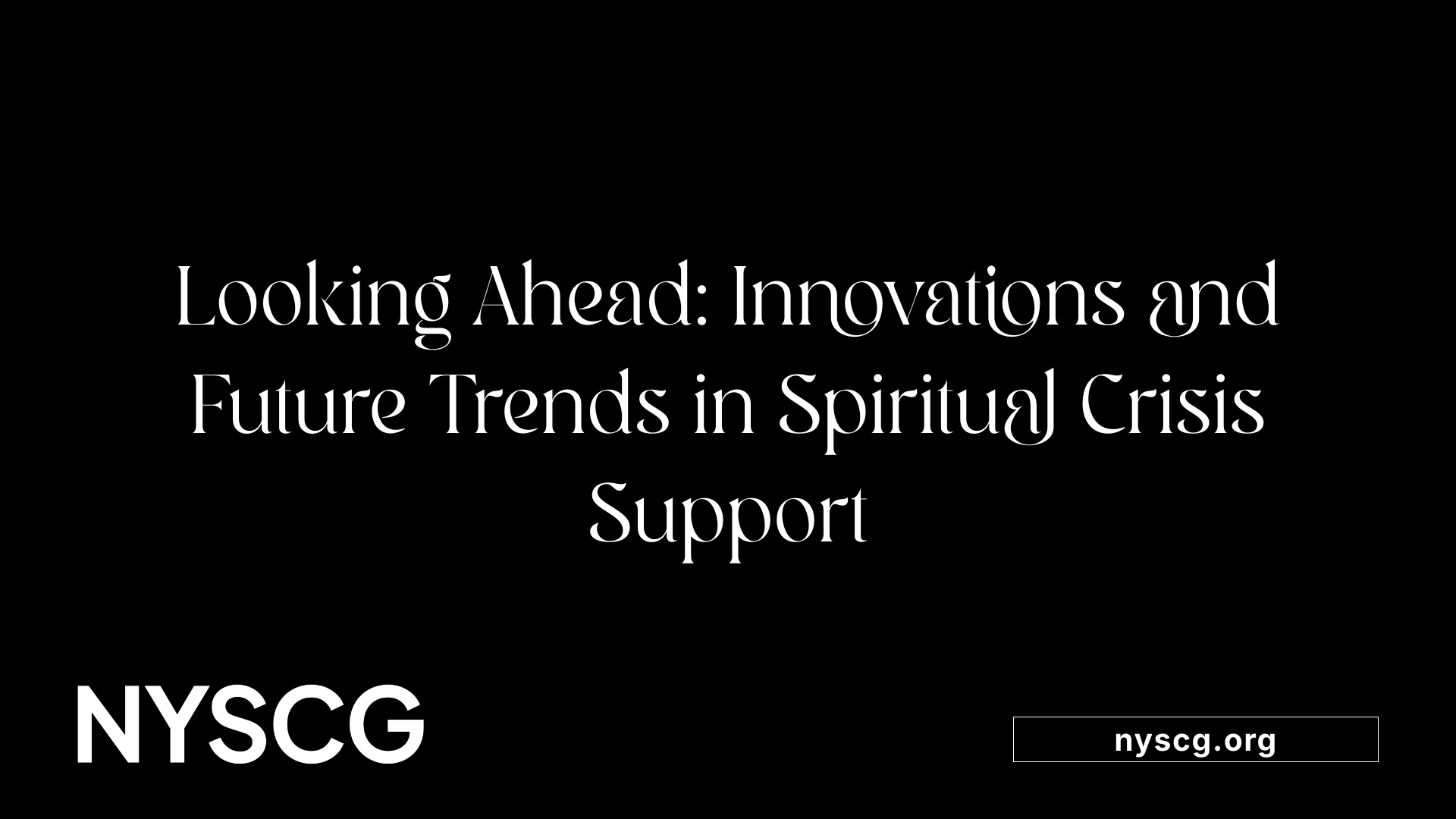A Complete Overview of Crisis Intervention for Chaplains


Crisis intervention is a vital component of holistic care, particularly within spiritual communities. For chaplains, understanding its principles, models, and applications is crucial to providing effective support during emergencies. This overview explores the core concepts, models, and practical strategies that empower chaplains to serve as competent crisis responders and ethical caregivers.

Crisis intervention is a short-term, structured process designed to help individuals cope with overwhelming events such as trauma, loss, violence, or severe illness. Its primary purpose is to prevent long-lasting psychological damage by providing immediate emotional support and stabilization.
This approach helps individuals manage their feelings, process difficult experiences, and regain their mental balance. Interventions often involve a careful assessment of the situation, establishing a trusting relationship, discussing the traumatic event, and offering reassurance. Models like the SAFER-R framework—short for Stabilize, Acknowledge, Facilitate understanding, Encourage, and Refer—guide practitioners through effective crisis management.
Crisis intervention is vital beyond personal support; it benefits organizations and communities by reducing the incidence of mental health crises, hospitalization, and escalation of distress. Trained responders such as healthcare providers, social workers, and chaplains are essential in providing timely aid.
By addressing emotional and spiritual needs during critical moments, crisis intervention fosters resilience and helps individuals find hope and direction. It connects those in distress to ongoing resources for recovery, supporting long-term mental well-being and strengthening community resilience.
In the context of spiritual care, crisis intervention not only offers practical support but also integrates spiritual guidance to foster hope, meaning, and spiritual strength amid adversity.

Crisis intervention employs structured approaches to quickly support individuals experiencing overwhelming events. One widely used model is Gilliland's six-step process, designed to provide clear guidance during acute crises. The steps include listening actively to identify the problem, ensuring the person's safety, offering emotional support, exploring possible solutions, helping formulate a plan, and securing commitment for follow-up actions.
Apart from specific models, the overall crisis management process is often divided into five phases: early warning and signal detection, preparation and prevention, damage containment, recovery, and learning and reflection. Each stage emphasizes the need for proactive planning and leadership. Effective crisis management involves acting swiftly to contain harm, supporting recovery, and learning from each experience to improve future responses.
Leadership qualities such as making quick decisions under pressure, confronting threats directly, and fostering positive change are essential across all phases. These models underscore systematic, proactive methods as crucial for minimizing damage and guiding individuals and organizations back toward stability.
Model/PhaseDescriptionFocus AreaGilliland’s 6-step modelListening, safety, support, solutions, planning, commitmentImmediate crisis responseFive-phase crisis managementDetection, prevention, damage control, recovery, reflectionOrganizational resilience and recovery
Detailed models such as Robert’s 7-stage crisis intervention framework provide comprehensive, step-by-step guidance for managing crises effectively. This structured approach begins with careful planning and initial crisis handling, followed by a biopsychosocial assessment to understand risk and context.
Establishing rapport and building collaborative relationships are crucial early steps, facilitating trust and openness. The model then guides responders to identify specific problem areas or emotional triggers, explore feelings and emotional responses, and generate tailored solutions to address immediate concerns.
Assessment of possible solutions involves evaluating options for safety and stability, which leads to developing a recovery plan. Follow-up and ongoing support ensure that individuals regain their functional capacity and emotional resilience.
StageDescriptionObjectivePlanning and crisis handlingInitial response and strategy developmentRapid stabilizationBiopsychosocial assessmentUnderstanding physical, emotional, social risksRisk management and context understandingRapport buildingEstablishing trust and collaborationFoundation for effective supportIdentify problem areasRecognizing primary stressors or issuesFocused interventionExploring feelingsEmotional processingFacilitation of emotional expressionGenerate and evaluate solutionsCreative problem solvingTailored coping strategiesRecovery and follow-upLong-term stabilization and supportResumption of daily functioning
For further details on crisis intervention models and steps, search using phrases like "crisis intervention frameworks" or "steps in crisis management." Staying informed about different approaches helps chaplains and mental health professionals refine their skills and adapt interventions to diverse situations.

Crisis intervention principles are central to the spiritual work of chaplains, enabling them to provide immediate and effective support during times of distress. These principles focus on quickly stabilizing individuals, reducing emotional and psychological damage, and fostering resilience.
Chaplains employ structured, evidence-based approaches such as the SAFER-PCI model, which guides their response to crises by emphasizing stabilization, assessment, and connection to further support. They create a safe, confidential space where employees or individuals can openly share their feelings, moral struggles, or traumatic experiences.
Using spiritual assessments, chaplains gauge the emotional and spiritual state of those in crisis, often incorporating culturally sensitive rituals and practices that respect individual backgrounds. Confidentiality is maintained to build trust, ensuring persons feel secure in expressing their vulnerability.
One vital aspect is spiritual resource integration, where chaplains combine narrative sharing, forgiveness, prayer, and reflection techniques to foster healing. Tools like Pastoral Narrative Disclosure (PND) help individuals process moral injury, encouraging moral reconciliation and spiritual reconnecting.
Chaplains also collaborate with multidisciplinary teams—including mental health professionals and emergency responders—to ensure comprehensive care. Their specialized training enables them to address moral injury, grief, and emotional pain effectively.
Overall, chaplains serve as vital responders in crises, blending spiritual and psychological strategies to help individuals find hope, meaning, and resilience amid overwhelming circumstances. This holistic approach ultimately supports emotional recovery and organizational resilience.

Chaplains benefit from a variety of specialized educational programs and resources aimed at strengthening their crisis response capabilities. One notable offering is the Crisis, Trauma, and First Response (CTFR) Certificate Course, which provides a solid foundation in emotional and spiritual care for first responders and disaster-affected individuals. This course emphasizes standardization of procedures across different agencies, ensuring consistent support during crises.
Organizations like the International Fellowship of Chaplains (I.F.O.C.) provide both in-person and online modules focusing on critical incident stress management, grief, and trauma recovery. These training opportunities often come with pathways for licensing and ordination, alongside ongoing professional development.
The Association of Critical Incident Stress Management (ACISM) and the International Critical Incident Stress Foundation (ICISF) offer comprehensive certification programs in crisis intervention, traumatic stress, and related domains. To qualify, chaplains usually need practical experience and must adhere to established ethical standards.
Additional organizations, such as the Billy Graham Rapid Response Team, deliver targeted training sessions like Sharing Hope in Crisis and CISM through live events and digital platforms. These courses equip chaplains with vital skills to address the emotional and spiritual needs of individuals and communities during emergencies.
Effective crisis response by chaplains hinges on thoughtful engagement and adherence to best practices. First, being fully present and actively listening without rushing to ask questions allows individuals to feel safe and understood. Validation of their feelings and encouraging healthy coping strategies are crucial to support emotional stability.
Chaplains should carefully assess the urgency of each situation, prioritizing responses to critical needs and collaborating with emergency responders to coordinate efforts. Maintaining communication protocols and following organizational guidelines help ensure safety and efficiency.
Providing ongoing follow-up and connecting individuals with additional mental health and social support services are vital components of a holistic response. Utilizing trauma-informed care principles and evidence-based models like Psychological First Aid enhances effectiveness.
Training in specialized crisis intervention techniques and familiarity with models such as the equilibrium or cognitive reframing methods bolster chaplains' ability to manage complex situations. Balancing spiritual, emotional, and physical support helps foster resilience and recovery.
Upholding ethical standards is fundamental for chaplains working in crisis scenarios. Confidentiality must be maintained meticulously to build and preserve trust with those they serve. Respecting diversity, including cultural and religious differences, ensures that support is inclusive and appropriate.
Collaboration with human resources, mental health professionals, and emergency teams is essential to provide coordinated care while clearly defining boundaries. Sensitivity to individual beliefs and avoiding proselytizing maintain professional integrity.
Furthermore, ongoing collection of feedback and participation in continuous professional development refine chaplaincy services. These ethical practices foster a respectful, responsive, and effective approach to crisis intervention, reinforcing the trust and integrity necessary for impactful support.
AspectDetailsAdditional NotesTraining OpportunitiesCTFR, I.F.O.C. modules, ICISF certifications, CISM coursesOnline and in-person options availableEthical CommitmentsConfidentiality, diversity, professional collaboration, feedbackMaintains trust and cultural competenceResponse Best PracticesActive listening, validation, follow-up, trauma-informed careEnhances recovery and resilienceFuture OutlookDigital chaplaincy, advanced training, integration with EAPs, impact measurementEvolving tools and methods for better support
This comprehensive approach to training, resources, and ethical practice ensures chaplains are well-equipped and principled in their vital role during crises.

Advancements in technology are shaping the future of spiritual and emotional care in workplaces. Digital chaplaincy offers remote support through video calls, messaging apps, and online platforms, making assistance accessible to employees regardless of location. This approach helps maintain confidential, immediate support during crises.
Training for chaplains and crisis responders is continuously improving. Future programs are expected to include virtual reality simulations, e-learning modules, and ongoing certification updates. These enhance skills in crisis assessment, cultural competence, and mental health first aid, ensuring chaplains are well-prepared for diverse and complex emergencies.
Greater collaboration between chaplaincy services and EAPs is anticipated. This integration offers comprehensive support, combining spiritual guidance with psychological counseling and practical resources. Such synergy enhances organizational resilience and provides holistic care.
Ongoing research is critical to understanding the effectiveness of spiritual care in crisis situations. Future efforts will involve developing metrics to evaluate outcomes, employee satisfaction, and resilience building. Evidence-based practices will help tailor services and demonstrate the value of chaplaincy in workplace crisis management.
Future TrendDescriptionBenefitsDigital chaplaincyRemote support via digital platformsIncreased accessibility, immediate responseEnhanced trainingInnovative learning methods and certificationsBetter preparedness, diverse skillsetsEAP integrationCollaboration between chaplains and mental health servicesHolistic employee support, stronger resilienceImpact researchEvaluation tools for spiritual care effectivenessData-driven improvements, justification for services
As frontline spiritual caregivers, chaplains occupy a vital role in crisis intervention. By understanding core principles, models, and ethical practices, they are better equipped to address the multifaceted needs of individuals and organizations during traumatic events. Continued education, innovative training, and the adoption of emerging technologies will further enhance their effectiveness, ensuring they remain essential pillars of resilience in diverse emergency contexts. Embracing these advancements enables chaplains to deliver compassionate, culturally sensitive support that fosters hope and healing amidst crisis.
All you need is the will to make the world a better place.
New York State chaplain group inc. is a tax deductible organization with a federal tax Id number 92-383-4921